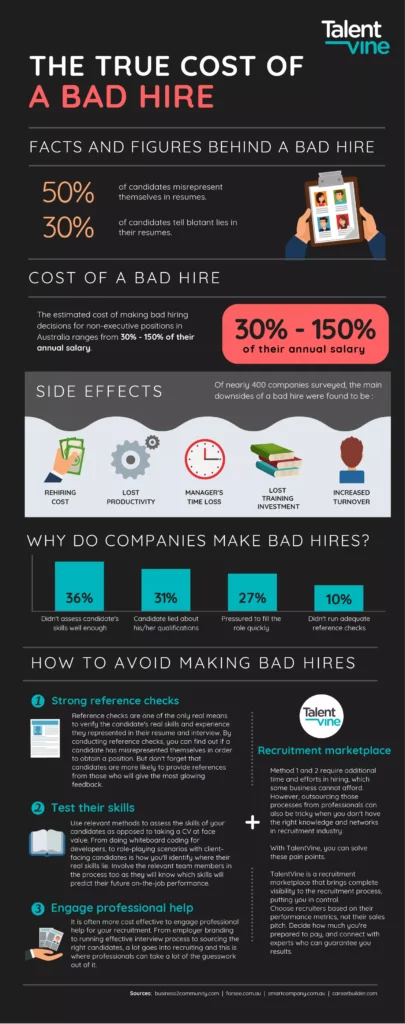Recruitment KPIs and Talent Acquisition Metrics are tools made to evaluate the recruitment aspect of many HR departments so they can visualize their performance. Recruitment KPIs and Talent Acquisition Metrics are the keys to showing upper management, as the CFO, how well the HR department is doing its job.
Those in upper management in companies tend to forget how crucial the recruitment and hiring aspect of the human resource department can be. Usually, they just ask for reports about how many new employees have been hired to replace the old ones or those that have been fired.
However, those numbers alone do not show the reality of the hiring process. The numbers will show the new hires, but not necessarily the quality of the said hires or their satisfaction with the hiring process.
When looking to recruit new people into the company, they must almost always be of the best quality so they may uphold the respect and integrity of the company. However, for upper management to see how well the human resource department is doing, they need more than just the number of recruits.
In this article, we’re going to talk about talent acquisition metrics. But, what exactly are KPIs and Metrics?
Recruitment KPIs and Metrics
KPI stands for Key Performance Indicators, which are vital tools of measurement that gauge a certain aspect or possibly the entire recruitment performance and process. KPIs can allow management and HR themselves to see and tackle areas that can use some improvement or simply just more attention.
KPIs are also very helpful in bringing the entire department, company, or organization closer to its goal. KPIs, by their definition, should be in every way related to company goals, as they can serve as measurements of such goals. These tools can help departments and companies see how close they are to achieving their long-term and short-term goals.
Metrics, on the other hand, are tools that measure business performance. These tools give a technical overview of specific areas in the business, such as the recruitment process.

Still confused? Let’s have an example.
The CEO of the company wishes to see how many recruits have joined the company, so you, as the head of the HR department, show him exactly just that. Upon seeing the numbers, he then asks to see how well the department with the new hires is doing, so you give him different numbers and charts to show their performance.
In the example, the number of new hires is a metric, while the different numbers and charts are KPIs. However, you should also understand that all KPIs are metrics, but metrics are not KPIs.
Are Recruitment KPIs and Talent Acquisition Metrics Important?
Yes, recruitment KPIs and talent acquisition metrics are very important in the HR department. This shows how well the department is doing its job in almost every aspect possible.
Though some metrics may be a hassle to learn, the use of such will make great differences in both the department alone and the company itself.
To start using KPIs in your department, here are 5 key recruitment KPIs and talent acquisition metrics you will need to learn!
Offer Acceptance Rate
The first and arguably most important metric and key performance indicator is the offer acceptance rate. This KPI allows you to track how many candidates, after a successful application and interview, are willing to take you up on your job offer. Their acceptance of the offer shows how pleasing your company is in the eyes of the public as well as other candidates.
Calculating the offer acceptance rate is pretty simple, as it is usually presented as a percentage. You only really need two variables, which are the number of accepted job offers and the total number of job offers extended.
Simply divide the number of accepted job offers by the total offers extended, and multiply that product by a hundred. The value you will get should always be presented as a percentage.
Number of Accepted Job Offers Total Offers Extended 100 = Offer Acceptance Rate
Let’s say that the head of the human resource department asks for the offer acceptance rate in the last quarter of 2021. You have the number of accepted job offers and the total number of job offers extended ready, which are (hypothetically) 98 and 150, respectively. After doing the math, you should end up with 65.33% as the offer acceptance rate in the last quarter of 2021.
Why is it important?
The offer acceptance rate is a crucial KPI to learn because it can help lead you to localize any issues within the recruitment process. Having a low acceptance rate could indicate many different issues, such as, but not limited to, the reputation of the company, the competitiveness of the salary and benefits, or even the time to hire.
Combining the offer acceptance rate with other KPIs and metrics like the time to hire, sourcing channel efficiency, or even just compensation negotiation can further bring the real issue into focus. Such is true to other KPIs, as no KPI or metric in the department is independent of another, and using the right one at the right time can help boost performance.
The offer acceptance rate doesn’t only show issues and focal points on the department and company’s side, but also candidate preferences as well. Having a constant and high offer acceptance rate could mean that candidates, recruits, and employees find themselves comfortable in your company.
Putting the offer acceptance rate in a trend line can help both the department and the company keep track of its performance. Trend lines can show how the offer acceptance rate is correlated to time. Localizing the time can then help the department determine issues at that specific point in time.
Recruitment Metrics: Number of Qualified Candidates
Also known as “Qualified Candidates per Opening”, this key performance indicator can help determine problems and lack of performance in the sourcing aspect of the recruitment process. This KPI shows how many qualified candidates are applying for or simply taking interest in a certain job opening.
It’s easy to find a large number of candidates for just one job opening, but it is hard to find candidates with the best qualifications to suit the position in the company. This KPI can help the human resource department to determine how well it is doing in seeking candidates and recruits for its job openings.
Unlike the offer acceptance rate KPI, the number of qualified candidates is presented as a simple ratio. Similar to the offer acceptance rate, on the other hand, the number of qualified candidates KPI only uses two variables, which are the number of candidates management presume the qualified and total number of candidates after initial screening.
As it is a ratio, you simply have to divide the number of candidates management presume qualified divided by the total number of candidates after initial screening. Presenting the ratio can also be as simple as adding “is to” in between the two numbers, or indicating the quotient as the ratio itself.
Number of Candidates Management Presume QualifiedTotal Number of Candidates After Initial Screening= Number of Qualified Candidates
Assuming that in the last quarter of 2021 there were 10 qualified candidates out of the 30 candidates who passed the initial screening, there are two ways the ratio can be presented. First, you could simply say that there are 10 out of 30 qualified participants in the last quarter of 2021. You could also simplify it by saying that only one in every three participants is a qualified candidate.
Why is it important?
The qualified candidates per opening KPI can help determine whether the department needs to focus and improve on the sourcing phase of the recruitment process or not. This could determine the issues present in the phase, such as the qualifications of those in charge of sourcing, the efficacy of the advertisement itself, or the sourcing channel efficiency.
This KPI is also crucial when it comes to saving time, money, and effort, as choosing unqualified candidates can be detrimental for the company in the long run. Setting standards as to what a qualified candidate is should ensure that the company is also putting its money in the right place so it can get closer to achieving its goal.
Bringing only qualified candidates into the company increases the guarantee that you and the rest of the department are doing all that you can to aid the organization.

Sourcing Channel Efficiency
When paired with the number of qualified candidates’ KPI, this key performance indicator helps with focusing on the issues in the preferred mode of sourcing by the company. The sourcing channel efficiency KPI can help you and the company save some money by no longer using sourcing channels that are not turning up qualified candidates for job openings.
When companies use multiple channels and modes to source potential candidates for openings, it is almost always certain that not all channels will produce candidates that management deem to be qualified. Some sourcing channels can be more effective and efficient than others, which is where the company should focus recruitment funding.
Similar to the offer acceptance rate key performance indicator, the sourcing channel efficiency KPI is presented as a percentage, and it only makes use of two variables. The first variable is the number of qualified candidates acquired from a certain source, and the second is the total number of applicants from all sources.
Determining how effective a sourcing channel also means you have to determine how much it makes up for the total number of applicants gotten from all sources. Simply divide the number of qualified candidates acquired from a specific source by the total number of applicants gotten from all sources. Multiply the product by 100 and you will have the percentage.
Number of Qualified Candidates Acquired from a Specific SourceTotal Number of Applicants Gotten from All Sources100=Sourcing Channel Efficiency
Assume that with 100 total number of applicants from all sourcing channels, 50 qualified candidates come from Channel A and 25 qualified candidates come from Channel B. Putting this in the equation, Channel A would have 50% channel efficiency, and Channel B would have 25%. This means that Channel A is more efficient than Channel B.
Why is it important?
Knowing which sourcing channels are most efficient for acquiring qualified candidates allows the department to direct the budget to another aspect of the recruitment process. This way, both money, and effort are saved by letting go of paid sourcing channels that only return unqualified candidates.
Measuring the effectiveness of the different sourcing channels the company is using like various job boards, social media, and email campaigns can help the department increase its focus on the sourcing channels with the highest turn-out rate of qualified candidates that best suit the job offer. Increasing focus in various ways can improve efficiency, eventually leading to having more qualified candidates apply to future job openings.
Cost per Hire
The cost per hire talent acquisition metric helps both the department and the company determine the different factors that come into play in hiring even just one candidate. With the cost per hire metric, companies can pinpoint any anomalies in the budget of the human resource department, may it be an excess or insufficiency.
The cost per hire metric is easy to calculate and is presented as a regular currency. This metric also only uses two variables, which are the total recruiting cost and the total number of hires at a certain point in time. From these two variables alone, you can already get a grasp of how much each hire your team made.
Simply divide the total recruiting cost by the total number of hires you made at a certain point in time. This way, the cost for each hire is evenly distributed among each successful hire, even if the cost of one successful hire is higher than the others. This metric provides an average cost for a single hire, which can easily be visualized with a trend line.
Total Cost of Recruitment at a Specific Point in Time Total Number of Hires at the Same Time=Cost per Hire
Let’s say that for the last quarter of 2021 you were provided with a budget of 1000 USD for recruitment and that this budget was used in its entirety. Looking at the record, you manage to successfully hire 100 qualified candidates. Putting this into the equation, each hire would cost 10 USD.
Why is this important?
Once you manage to determine the average cost for each successful hire, you can then look at the various factors that affect the cost. Some of these factors can be recruitment time costs, travel costs, administrative costs, and even the costs of managers and employees involved in the hiring process. Tackling any irregularity from there would be easier since you have a better focus.
Quality of Hire
The quality of hire talent acquisition metric is undoubtedly one of the – if not already the most important metric in the human resource department. This metric alone can determine whether hiring a candidate was truly worth all the time, effort, and money placed into the process alone. There can be many qualified candidates, but choosing the perfect candidate is the hardest part of any recruitment.
However, the quality of hire metric is a difficult one to tackle, as there is no single formula that will fit every company’s needs. On the bright side, this metric also makes it easier for companies to measure and keep track of their goals because of how easy it can be to tweak.
Because this metric is a qualitative metric and not a quantitative one like those previously discussed, there are many ways one can measure the quality of hire in any employee. Measuring the quality of hire can be done through assessing employee performance, manager’s satisfaction with employee performance, company tenure, and even customer satisfaction.
By assessing the quality of hire in your employees, you will also be able to streamline the recruitment process to avoid or at least lessen the chance of hiring candidates of poor quality. This is highly possible because you will then be forced to determine whether the now-employee is working to achieve company goals or not.
Furthermore, you will also be able to identify whether the recruitment methods and processes you employ are effective and beneficial for the company. By focusing on only the candidates with the best qualities that benefit the company, you are saving the organization crucial time and money, allowing it to focus on other aspects.
In Conclusion
These 5 recruitment KPIs and talent acquisition metrics are enough to make the slightest improvements in the recruitment process of any human resource department. However, as previously mentioned, these 5 alone won’t be enough to help your company compete with top brands and businesses in the recruitment factor.
Employing these KPIs and metrics and associating them with what they are directly related to can make the biggest difference in any human resource department. Not only will recruitment issues be solved, but improvements in budgetary allocations for the department will also be realized.
By spending more time and effort to learn all the different recruitment KPIs and talent acquisition metrics, you will be able to see an enhanced recruitment process. This then can lead to hiring more quality candidates, which will potentially increase your budget. An increased budget means a more enhanced process, and so it goes in the recruitment cycle. Happy learning!

